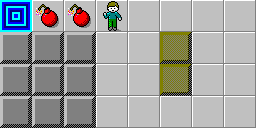Block Donut Rule: Difference between revisions
Tylersontag (talk | contribs) m (Tylersontag moved page block Donut Rule to Block Donut Rule over redirect: revert) |
Tylersontag (talk | contribs) (Removing example of when block donut doesn't work because it's both obvious and not similar to typical block donut situations) |
||
| (One intermediate revision by the same user not shown) | |||
| Line 5: | Line 5: | ||
[[File:Block Donut Rule.png]] | [[File:Block Donut Rule.png]] | ||
The Block Donut Rule is going around to the ''right'' side of the blocks and moving block 2 L, then pushing block 1 U and 3L into a bomb. The two paths form a donut, which gives the rule its name. Compare this to starting by pushing block 2 R from the left side. While the Block Donut Rule's path is initially 2 moves longer, it places the block 2 spaces closer to its target, saving ''four'' moves, and thus gaining two moves net. Not all situations trade the two moves; sometimes, Chip will already be on the opposite side, and therefore the Block Donut Rule will be worth four extra moves. | |||
One noticable example of the Block Donut Rule in actual play is in the five-block room in the southwest of [[Mix Up]], after three of the blocks have been removed. There is a stack of two blocks in the center of the room, and moving the lower block L rather than R yields an equivalent situation to example one. | One noticable example of the Block Donut Rule in actual play is in the five-block room in the southwest of [[Mix Up]], after three of the blocks have been removed. There is a stack of two blocks in the center of the room, and moving the lower block L rather than R yields an equivalent situation to example one. | ||
Latest revision as of 03:05, 7 May 2021
The Block Donut Rule is a principle of block pushing, concerning the fastest way to get two or more blocks in a chain which points towards their intended path, containing one or more turns, out through to an identical destination.
The simplest situation where the Block Donut Rule is usable is something such as this:
The Block Donut Rule is going around to the right side of the blocks and moving block 2 L, then pushing block 1 U and 3L into a bomb. The two paths form a donut, which gives the rule its name. Compare this to starting by pushing block 2 R from the left side. While the Block Donut Rule's path is initially 2 moves longer, it places the block 2 spaces closer to its target, saving four moves, and thus gaining two moves net. Not all situations trade the two moves; sometimes, Chip will already be on the opposite side, and therefore the Block Donut Rule will be worth four extra moves.
One noticable example of the Block Donut Rule in actual play is in the five-block room in the southwest of Mix Up, after three of the blocks have been removed. There is a stack of two blocks in the center of the room, and moving the lower block L rather than R yields an equivalent situation to example one.
